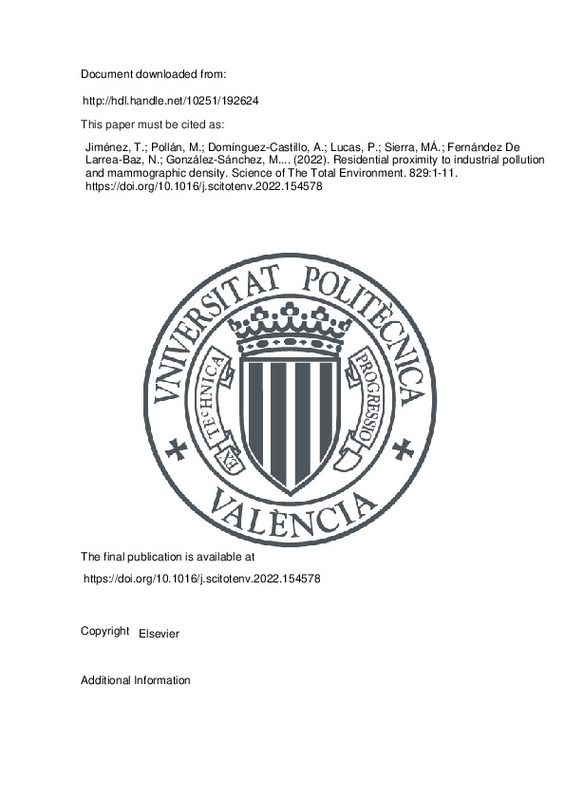JavaScript is disabled for your browser. Some features of this site may not work without it.
Buscar en RiuNet
Listar
Mi cuenta
Estadísticas
Ayuda RiuNet
Admin. UPV
Residential proximity to industrial pollution and mammographic density
Mostrar el registro sencillo del ítem
Ficheros en el ítem
| dc.contributor.author | Jiménez, Tamara
|
es_ES |
| dc.contributor.author | Pollán, Marina
|
es_ES |
| dc.contributor.author | Domínguez-Castillo, Alejandro
|
es_ES |
| dc.contributor.author | Lucas, Pilar
|
es_ES |
| dc.contributor.author | Sierra, María Ángeles
|
es_ES |
| dc.contributor.author | Fernández de Larrea-Baz, Nerea
|
es_ES |
| dc.contributor.author | González-Sánchez, Mario
|
es_ES |
| dc.contributor.author | Salas-Trejo, Dolores
|
es_ES |
| dc.contributor.author | Llobet Azpitarte, Rafael
|
es_ES |
| dc.contributor.author | Martinez, Inmaculada
|
es_ES |
| dc.contributor.author | Pino, María Nieves
|
es_ES |
| dc.contributor.author | Martínez-Cortés, Mercedes
|
es_ES |
| dc.contributor.author | Pérez-Gómez, Beatriz
|
es_ES |
| dc.contributor.author | Lope, Virginia
|
es_ES |
| dc.contributor.author | García-Pérez, Javier
|
es_ES |
| dc.date.accessioned | 2023-03-27T18:01:33Z | |
| dc.date.available | 2023-03-27T18:01:33Z | |
| dc.date.issued | 2022-07-10 | es_ES |
| dc.identifier.issn | 0048-9697 | es_ES |
| dc.identifier.uri | http://hdl.handle.net/10251/192624 | |
| dc.description.abstract | [EN] Background: Mammographic density (MD), expressed as percentage of fibroglandular breast tissue, is an important risk factor for breast cancer. Our objective is to investigate the relationship between MD and residential proximity to pol-lutant industries in premenopausal Spanish women. MeOds: A cross-sectional study was carried out in a sample of 1225 women extracted from the DDM-Madrid study. Multiple linear regression models were used to assess the association of MD percentage (and their 95% confidence in-tervals (95%CIs)) and proximity (between 1 km and 3 km) to industries included in the European Pollutant Release and Transfer Register. Results: Although no association was found between MD and distance to all industries as a whole, several industrial sectors showed significant association for some distances: "surface treatment of metals and plastic" (j3 = 4.98, 95%CI = (0.85; 9.12) at <_1.5 km, and j3 = 3.00, 95%CI = (0.26; 5.73) at <_2.5 km), "organic chemical industry" (j3 = 6.73, 95%CI = (0.50; 12.97) at <_1.5 km), "pharmaceutical products" (j3 = 4.14, 95%CI = (0.58; 7.70) at <_2 km; j3 = 3.55, 95%CI = (0.49; 6.60) at <_2.5 km; and j3 = 3.11, 95%CI = (0.20; 6.01) at <_3 km), and "urban waste-water treatment plants" (j3 = 8.06, 95%CI = (0.82; 15.30) at <_1 km; j3 = 5.28; 95%CI = (0.49; 10.06) at <_1.5 km; j3 = 4.30, 95%CI = (0.03; 8.57) at <_2 km; j3 = 5.26, 95%CI = (1.83; 8.68) at <_2.5 km; and j3 = 3.19, 95%CI = (0.46; 5.92) at <_3 km). Moreover, significant increased MD was observed in women close to industries releasing specific pollutants: ammonia (j3 = 4.55, 95%CI = (0.26; 8.83) at <_1.5 km; and j3 = 3.81, 95%CI = (0.49; 7.14) at <_2 km), dichloromethane (j3 = 3.86, 95%CI = (0.00; 7.71) at <_2 km), ethylbenzene (j3 = 8.96, 95%CI = (0.57; 17.35) at <_3 km), and phenols (j3 = 2.60, 95%CI = (0.21; 5.00) at <_2.5 km). Conclusions: Our results suggest no statistically significant relationship between MD and proximity to industries as a whole, although we detected associations with various industrial sectors and some specific pollutants, which suggests that MD could have a mediating role in breast carcinogenesis. | es_ES |
| dc.description.sponsorship | We would like to thank the participants in the DDM-Madrid study for their contribution to breast cancer research. This work was supported by the Carlos III Institute of Health (AESI PI15CIII/0029, AESI PI15CIII/00013, and EPY-505/19-PFIS) . The article presents independent research. The views expressed are those of the authors and not necessarily those of the Carlos III Institute of Health. | es_ES |
| dc.language | Inglés | es_ES |
| dc.publisher | Elsevier | es_ES |
| dc.relation.ispartof | Science of The Total Environment | es_ES |
| dc.rights | Reconocimiento - No comercial - Sin obra derivada (by-nc-nd) | es_ES |
| dc.subject.classification | LENGUAJES Y SISTEMAS INFORMATICOS | es_ES |
| dc.title | Residential proximity to industrial pollution and mammographic density | es_ES |
| dc.type | Artículo | es_ES |
| dc.identifier.doi | 10.1016/j.scitotenv.2022.154578 | es_ES |
| dc.relation.projectID | info:eu-repo/grantAgreement/ISCIII//AESI PI15CIII%2F00029/ | es_ES |
| dc.relation.projectID | info:eu-repo/grantAgreement/ISCIII//AESI PI15CIII%2F00013/ | es_ES |
| dc.relation.projectID | info:eu-repo/grantAgreement/ISCIII//EPY-505%2F19-PFIS/ | es_ES |
| dc.rights.accessRights | Abierto | es_ES |
| dc.contributor.affiliation | Universitat Politècnica de València. Escuela Técnica Superior de Ingenieros de Telecomunicación - Escola Tècnica Superior d'Enginyers de Telecomunicació | es_ES |
| dc.description.bibliographicCitation | Jiménez, T.; Pollán, M.; Domínguez-Castillo, A.; Lucas, P.; Sierra, MÁ.; Fernández De Larrea-Baz, N.; González-Sánchez, M.... (2022). Residential proximity to industrial pollution and mammographic density. Science of The Total Environment. 829:1-11. https://doi.org/10.1016/j.scitotenv.2022.154578 | es_ES |
| dc.description.accrualMethod | S | es_ES |
| dc.relation.publisherversion | https://doi.org/10.1016/j.scitotenv.2022.154578 | es_ES |
| dc.description.upvformatpinicio | 1 | es_ES |
| dc.description.upvformatpfin | 11 | es_ES |
| dc.type.version | info:eu-repo/semantics/publishedVersion | es_ES |
| dc.description.volume | 829 | es_ES |
| dc.identifier.pmid | 35304152 | es_ES |
| dc.relation.pasarela | S\458931 | es_ES |
| dc.contributor.funder | Instituto de Salud Carlos III | es_ES |







![[Cerrado]](/themes/UPV/images/candado.png)

